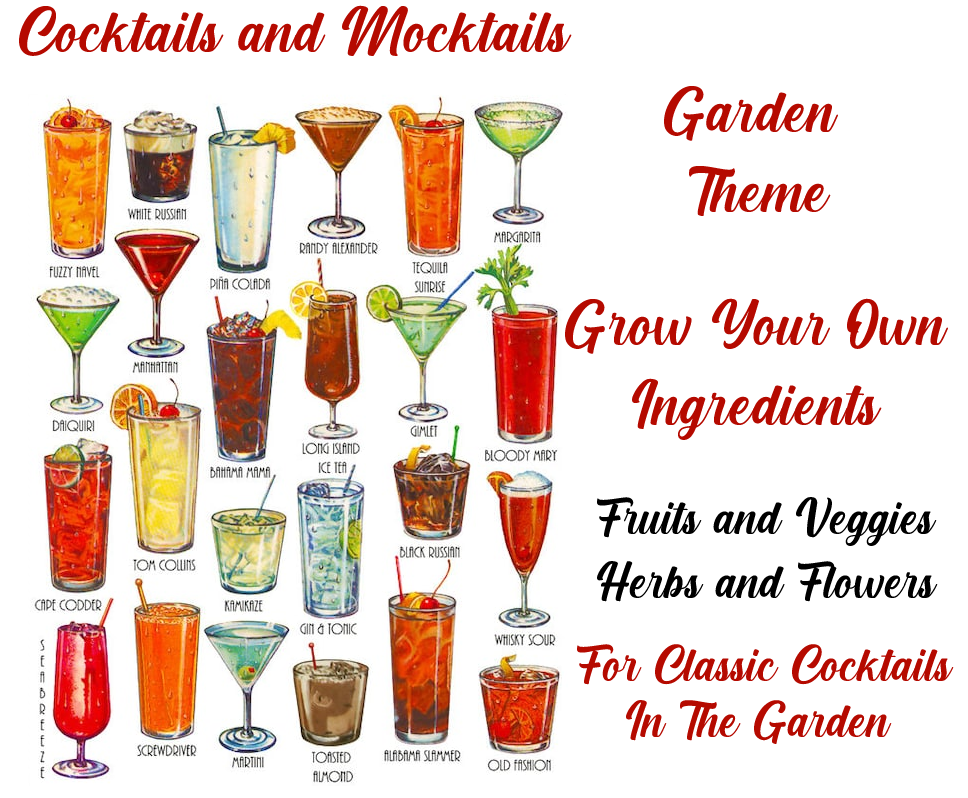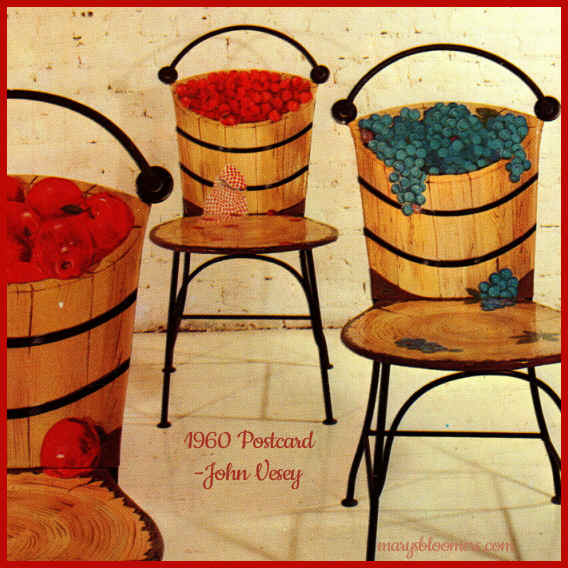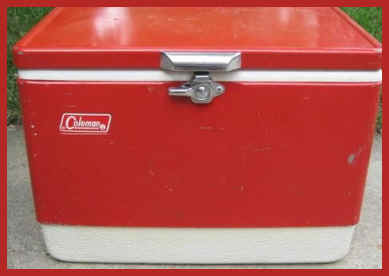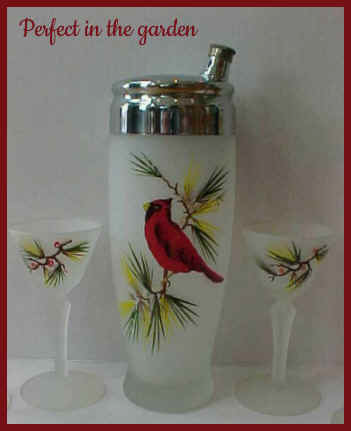Whether they're floated, soaked, muddled or hung over your glass, these are some things you can grow in your garden for a cocktail garden theme. Classic or modern cocktail themes or both. The best thing about it is that it can double as your herbal culinary and tea gardens and vice versa. The retro cocktail gathering is the theme, and the decor should be minimal and moveable, unless you're designating an area clearly for beach partying. It all depends upon the space you will be using, and how your house and yard styles fit into it. If you have a large property to work with, you can go full cabana, tiki bar and pool, but here, we're covering small space garden and a relaxing gathering theme. This plan is about growing the ingredients for cocktails, punches and other summer beverages. Decor is secondary. And whether you're serving cocktails or mocktails, the plant-based ingredients and appetizers can be the same, and the garden will be fragrant, tasty and lovely either way. A word about using edibles in your snacks and beverages - If your herb and veggie garden is not going to be organic, be sure to thoroughly wash any fruits, flowers and veggies that you will serve in your drinks to remove all traces of chemical residue. If you use chemical pesticides and fertilizers, you may not want to use these plants in your drinks at all. Even the herbals you might grow for medicines and teas should be organic. I am assuming that some chemicals will remain in the plants, so I wouldn't use them. You can still use this info to designate a separate little organic garden grown especially for the purpose of using homegrown plants in cocktails.
The cocktail garden I speak of, if decorated at all, would be perfect with a retro cocktail theme, would not be including a flashing neon sign, hula-skirted tables and parrots hanging in the trees, unless you're designing a tiki bar theme. This garden's theme decor would have an ornamental item here and there, perhaps a retro 1940's or '50s cocktail collectible or your seating area dressed in retro aluminum seating. Serving items would carry your theme. There were some really awesome glasses and barware, featuring the Atomic theme prevalent at the time. There were eye-catching chip and dip servers, lazy susan coffee table snack servers, nut bowls, chrome was big, and so was melmac and melamine serving and snack trays. You can use the retro metal picnic and camping accessories, like the metal seating pieces and tables, big metal picnic baskets and Coleman and Pelican glass and porcelain-lined vacuum drink coolers. I have a collection of those. A theme could combine a cocktail garden and outdoor picnic or retro cookout. That's how we rolled in the 50's. Find a vintage camping ice chest to keep the ice, cold drinks and appetizers in and use it on the patio - near your grill.
There are really a lot of ways to decorate your cocktail garden. And yes, you can do intentionally tacky and have flamingo and Hawaiian luau themes, if that's what you like best. I love it myself when it's planned well. You can plan a totally modern martini garden just as easily, but your decor and the garden area would be less nostalgic, and more of an ordinary outdoor bar. |
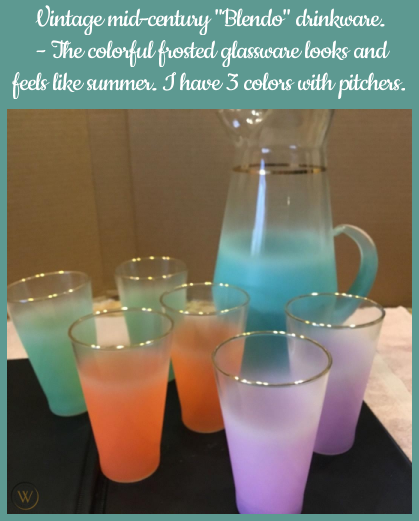 |
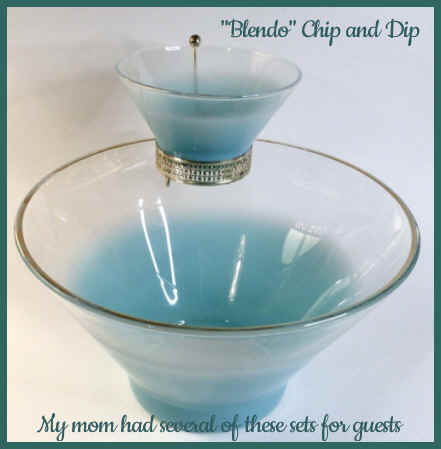 |
For a look at some ideas you can implement for a retro garden and backyard theme, visit this page.
Here are a few more examples of decorative and useful pieces for your retro party in your Cocktail Garden.
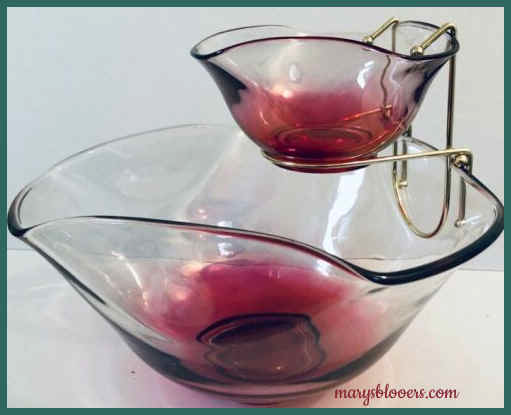 |
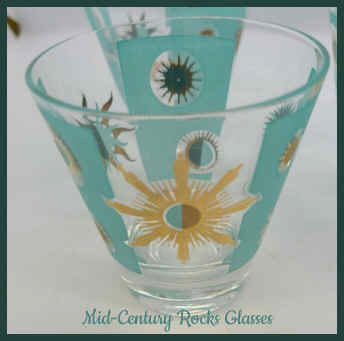 |
|
|
 |
Begin by creating a space for growing your cocktails, and a seating area for yourself, or for garden gatherings. There are some wonderful 40s and 50s reproductions for the furniture and accessories, and you can still find lots of the real accessories at flea markets, yard sales and antique shops. Consider the intent and use of the garden theme. Determine whether you're using it for after-work relaxation and a private or romantic cocktail break, or using it for large party gatherings, whether your home is a vacation home or your permanent residence, will you place it close to your home or in a garden retreat - your choice of space, the design, where you place accessories and the plants, depends upon that use as a guideline.
Grow the plants and dwarf fruit trees in large containers and raised beds, pick what you need when you need it, and preserve some for the holiday seasons. That leaves you lots of room for ornamental flowers and other edibles in-ground. Grow vertical when you can. I grow herbs at the bases of my little potted trees. Grow it just as you would any garden or backyard orchard.
Almost everything, except for any trees, can be planted in rows of 4 ft. elevated raised beds. No weeding and no critters feasting upon your crops. If you have a fenced in yard with privacy, line the perimeter with the planters with space between them for access. Once you do the perimeter (mine has the raised beds with potted dwarf trees between them), make the planters focal points or "plant" the planters in rows, with paths between. You won't believe how much food you can grow that way. Shady groundcovers and low-growing perennials are right at home in the space beneath the planter. I grow berries on trellises over the tops of plants in these elevated beds, as well. If you grow an organic garden, the groundcovers can be edibles, like the lovely creeping Lemon Thyme. The only challenge to edible groundcovers would be marauding animals like rabbits and deer eating it, if you don't have the area fenced in or enclosed in some way.
There are dwarf varieties of just about every fruit. A backyard orchard around your cocktail theme is very possible. You can also grow many garnishes.
Pick your ingredients when you need them to be sure they're fresh. Pick and save some, if you grow enough, for preserving.
Grow Roses, lavender, hibiscus and other flowering plants for garnishes and simple syrups, Spearmint, lemon verbena, cilantro and basil to mix or muddle into juleps and other delights, plus alpine strawberry, lavender, rosemary and Thai basil for flavor and garnishing, and to float in your drinks. Orange, lime and orange blossoms make nice additions to cocktails and desserts you might be serving. Lemon and lime leaves make a great garnish, and they are fragrant, as well.
Your cocktail garden can cater to alcoholic cocktails and mocktails, as well as punches. Grow your ingredients, decorate with a cocktail theme, then host a retro cocktail party in your garden. Or just grow the plants, herbs and fruits for your culinary use. If you are going to do the cocktail theme, you have lots of decor possibilities, retro to modern.
Grow most of your non-hardy fruits in big pots so that they can be easily plucked fresh when you need them. You can also grow many non-hardy fruits for your drinks by wintering the non-perennial varieties in the house. Those plants that don't go dormant, but are intolerant of frost, can make beautiful houseplants. Dwarf citrus trees indoors are very pretty, and the Meyer Lemons, in particular, grow flowers and fruits all the time. They look and smell great. I successfully grow them indoors and they spend their summers outdoors, being brought in before the first frost, when night temps steadily dip into the 50's.
A surprising number of popular garnishes are from plants that are fairly easy to grow, such as citrus, mint and strawberries. Try growing celery and make maraschino cherries from a dwarf cherry tree in your backyard. I grow the sweet and the sour types for processing into preserves, and making "drunk berries" to preserve for cocktails. Celery does best in cooler weather, so plan to plant in early spring in warm winter climates. It needs regular water and fertilizer.
To grow an ornamental wine garden, grow the grapes and herbs used in wine-making, like Dandelion and elderberry leaves and flowers.
If your garden's center will be a seating area deck or patio, and you don't have a rolling bar, place the plants nearest the kitchen in raised beds.
Almost all fruits and veggies can be "drunken" - soaked in a jar with whatever liquor you like and it lasts for months. Ready to float in your drink anytime. My favorite soakers are raspberries, blackberries and strawberries. And mine are covered and stored in coconut rum, gin or vodka. Melon tastes great soaked in any type of liquor. It also makes a terrific floating frozen ring for punch.
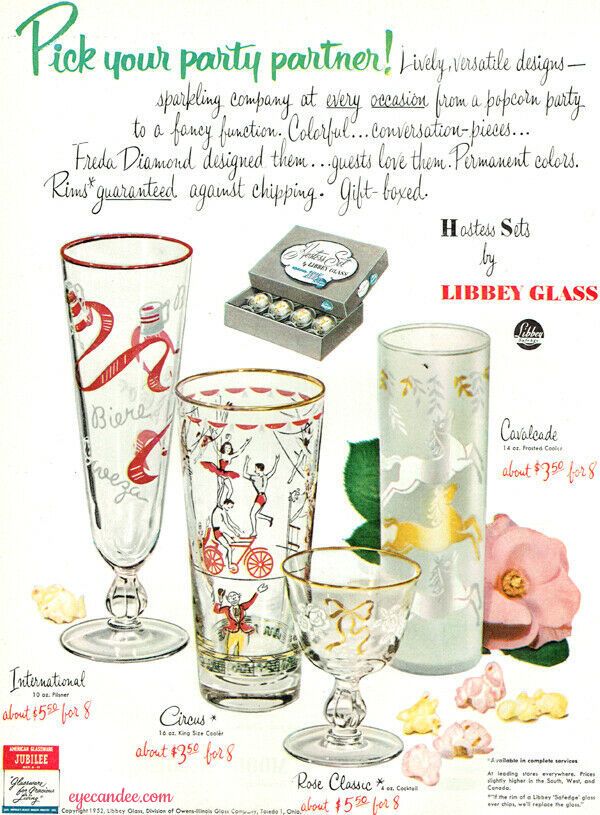 |
Olives - Yes, you can grow a
potted olive tree.
Ginger Root
Stevia - this herb can be your sweetener - from making simple syrups, to sweetening mints for Mint Juleps.
Homegrown tomatoes, celery, and maybe some
hot peppers
These will make your Bloody Mary's sing.
Cherry tomato - from teeny to
whatever size you like. These come as tall shrubs, short shrubs, and dwarf
vines.
I recommend Red 'Tumbling Tom'. Quite dwarf. Very pretty shades of red, yellow and orange
during different stages of growth. Sweet, firm with
a nice crunch. Can be planted in raised beds, pots and hanging baskets.
Large clusters of fruits. They
need no staking. An early variety and very prolific. The more you pick, the
more you get. Fruits between 1-2 inches diameter. I grow 3 plants per 4 ft.
raised and elevated garden bed. They're very pretty tumbling from the sides
of pots and beds.
Pest and disease resistant. Grow one plant per person, and that's all you
and your family will need all season for eating salads and for beverages.
Cucumber
Tasty floated in any cocktail. Cool and refreshing. Not at all frost-hardy.
Should be staked so that it can climb, rather than crawl along on the ground.
Mangoes - Dwarf potted trees are easily grown.
Pomegranate - Grenadine syrup used in cocktails is made from pomegranates. There are quite a few ornamental and tasty varieties of dwarf pomegranate trees for growing in pots. They are also very good for your health.
There are many different types, from tall to low groundcover.
Hot peppers - Jalapenos and other spicy peppers are
frequently used in drinks and appetizers.
.-The Peruvian Pearl Pepper - a favorite
choice of mine in just about anything. Also known as Biquinho peppers
Perennial that can be grown indoors in winter.
This is my pick for a sweet and spicy pepper that can be tossed into a
drink without doing any work to prep it. They're adorable lined up on long
toothpicks. These red cuties are small and shaped
like pearls, and these are usually preserved roasted and pickled. Then, they
become little sweet and spicy snacks. They're naturally sweet and smoky fresh
off the plant, with a nice touch of heat. They can be eaten raw or preserved, and
you eat seeds and all. I find them addictive. These peppers can be grown indoors and
out. They are hot weather plants, so bring them
inside for winter and grow them with grow lights.
The little peppers are sometimes roasted and pickled in a sweet and tangy brine for later use in cooking and drinks. I love these cute little tidbits, fresh or pickled, in my salads, roasted into my tomato preserves, and on my sammiches. I don't see why they can't join basil and oregano in alcoholic concoctions. When roasted, it can also be ground and used much like pepper. Fertilizer is not needed, and it only needs to be watered when the weather is extremely dry. I like it in stir fries, chilis, sauces, dips and veggie preserves. I would probably preserve a batch of them in pickling spices meant for bread and butter pickles. Seriously delicious. I can see them floating in my G&T.
Grow it in pots. Once established, it might become a tough plant to get rid of if you plant it in-ground. Not a problem when you plant in pots or controlled environments. Like most peppers, they need a long, hot growing season, and 90+ days to ripen from seed. The plants grow 2-3ft. high and wide. They grow in sun or shade. They do well indoors under grow lights.
Pearl Onions
Pearl
Onions are small pearl-shaped onions
that are usually ¾ to 1¼ inches wide. · Their taste is sweet and mild.
A cocktail onion is usually a pearl onion pickled in a
brine with small amounts of turmeric and paprika. Pearl onions are naturally
sweet, which makes them an excellent pairing with many cocktails. They're also
tasty glazed or roasted in an appetizer. Pearls are harvested 60 to 90 days
after planting, when the bulbs are about 1 to 2 inches in diameter. These
onions are sweet rather than pungent like larger onions.
Basil
Semi-sweet, with an anise flavor. Harvest leaves as desired. Not frost-hardy.
I pluck young leaves all summer long for my Caprese Salads and Marinara
Sauce. There are several varieties of basil. I grow them in clay pots near
their fave herb and veggie companions all summer, then indoors on my
windowsills for pinching leaves all winter. Pinch stems early and often
to stimulate bushy growth. Sweet Italian Genovese basil is my favorite
for cooking and in salads. Thai Basil is quite tasty in cocktails. Some basil varieties have
edible flowers that don't have to be pinched off and discarded, and that
you can happily pinch off and use in your drinks and
salads. Basil and tomatoes are best friends and make great roomies. I
sometimes add a leaf or two of basil to float in a Bloody Mary with a
teeny cherry tomato or spicy pearl pepper.
Coriander
Coriander is known for being difficult to grow. Mostly due to its bad
habit of quickly rushing to flower and setting seed (bolting).
Probably the easiest way to maintain a good supply of fresh coriander is
to plant seeds every few weeks from September right though until the end
of autumn.
Shiso
Depending on the variety, the Japanese
herb tastes like mint, cinnamon, clove, citrus, cumin, cilantro
and basil. Plant in pots, as it has a reputation for becoming just as invasive
as mints. In effect, if you can grow a few different varieties of this,
you can eliminate all the separately mentioned herbs grown for cocktails,
and save space in the garden for ornamentals. Grow in pots to confine
them. Harvest leaves as
needed throughout the season. Not frost-hardy. Remove flowers to prevent
self-sowing seeds, as this plant can become quite invasive in open
ground.
Chives - Perennial
Plant in the garden anytime. Hardy
perennial.
Use the flowers in drinks and
salads.
Lemon verbena - Perennial
Creeping Lemon thyme -
Perennial
Pretty lavender flowers, low-growing. Creeping thyme can be grown at the bases of plants in
pots or in beds, and it is a fragrant and edible. It is lightly steppable,
and looks pretty growing between stones on paths and in rock gardens.
Lemongrass - Perennial
An ornamental grass used in Vietnamese cuisine, and in soups, beverages
and salads.
Mints - All types are flavorful
Invasive
Perennials if not contained.
Famously used in Mint Juleps -
especially for cocktails on Kentucky Derby Day in the south. It's also
used in Mint Julep Martinis. Do not grow these directly in the soil,
you'll never get rid of it. if you don't have to. Plant several
pretty planters with varieties you like. Pinching it frequently for
culinary and remedy uses makes it very happy, and keeps the plants bushy.
It grows indoors on windowsills and outside in anything. All mints are invasive. Mints need
full sun all day and lots of water. Spearmint, Mojito Mint, Chocolate mint,
Pineapple mint,
Lemon mint, Peppermint, Ginger mint, Mexican Mint. ALWAYS grow mints in pots.
Mints are aggressively spreading plants that will take over your landscape and the neighbors' in no time. You will never rid yourself of in-ground mints. I once had what I planned as an herb bed turn entirely into a mint bed, and I lost everything but the mint, which I was determined to control and eradicate. Pinch as much as needed for cocktails, teas and culinary delights. They look pretty planted in big, shallow succulent bowls. I wouldn't plant them with any other plant.
I prefer to use Hummingbird Mint
(agastache) for my minty things and for the hummers.
**Dwarf Agastache - Hummingbird Mint (Hyssop) - Perennial in zones
5-9
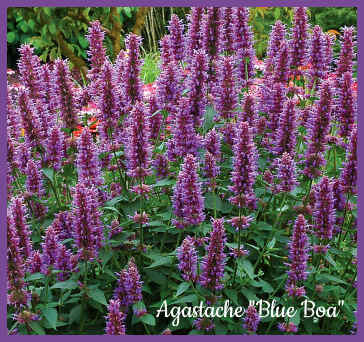 |
New favorite perennial plants in my garden for flavorings, teas and Hummingbirds. "Poquito Butter Yellow" and "Blue Boa" Agastache (Hummingbird Mint) are dwarf, compact varieties, and a very pretty plants with yellow, pinks and dark lavender spike flowers that attracts hummingbirds, butterflies and other pollinators all day. It is a fast grower and showy in pots and containers. No pruning needed. I like to grow it in pots with a taller plant in similar colors, like dwarf coneflowers, in the center of a planting. It's leaves smell and taste like mint, and some varieties smell like anise or licorice. It's leaves and flowers are used in teas, and the blossoms are very pretty floating in a glass. Highly recommended ornamental, aromatic and edible plant. Much prettier and than other herbal mints, and you get hummingbirds. It comes in about 8 varieties, and these grow to 2-4 feet tall. Grow this in a bird and butterfly garden, and pick it for a minty flavor in your cocktails and recipes. Beauty and pollination for all of your plants and trees. Win/Win.
- Varieties include Mint or anise taste
- Attracts Butterflies
- Heat and Drought Tolerant
- Fragrant
- Attracts Hummingbirds and other pollinators
- Long-Blooming
- Great in Containers and Vases
I plant the dwarf variety that I can grow in pots and not worry about the invasiveness that some mints are known for. Mine grow with other fruits, like fig and strawberry, all in pots and raised beds. This is done because pollinators are attracted to the flowers, and my berry flowers are being openly pollinated. 4 plants in a 16-inch pot fills it beautifully. And it's a joy to split it up into more plants. This is an easy and cheerful plant that can be used to hide a lot of ugly around foundations, stumps, and is lovely perched on steps. Cutting off dead flowers and pinching off leaves for drinks, teas and salads encourages the plan to rebloom until fall. It smells so good, i sometimes run my fingers through it to straighten the flowers, on purpose.
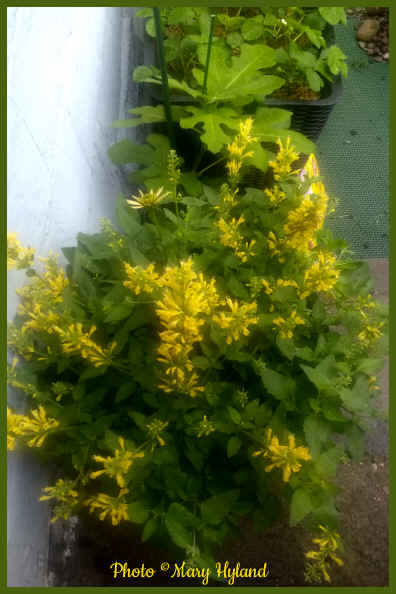 |
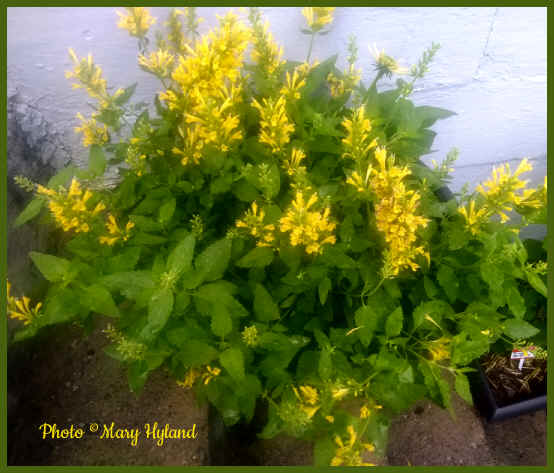 |
Click the pic below to
view a 1938 magazine ad and recipe for Mint Juleps.
Crush Agastache leaves
for the minty taste in the same old-fashioned way.
Oregano - Perennial - Several types. I plant Greek and ornamental varieties in my perennial herb beds.
Tarragon - I love
tarragon in my cooking. I am attracted to it's earthy taste and how it
makes my roasts sing. It's used in gin and tonic cocktails.
It's aso mixed into a simple syrup, and paired with strawberries and lime
in cocktails. It's featured in "Strawberry Smash" cocktails.
Tarragon is a perennial herb with long, light green leaves and tiny
greenish or yellowish white flowers.
Lovage - Tastes like celery
Hardy Hibiscus - Perennial
Used in margaritas and vodka cocktails with jalapenos and mint.
Nasturtium
Edible flowers frequently used
in cooking and salad-making. Very pretty plant that adds a peppery taste.
Keeps bugs from chewing your plants.
Lavenders - Perennial
Lavender and gin go together. The floral addition brings out the flavor of the gin. If you also grow low-growing dwarf juniper, you'll appreciate the gin's beginnings even more. English lavender is sweeter than others, but less hardy. I like the pretty flowers of my pink variety floating in my teas and drinks, and sprinkled over icings. Use the flowers and the leaves in cocktails, mocktails and for sweet desserts. They're yummy when sugared, like violets.
Vines
Jasmine, honeysuckle, climbing roses, and other perennial vines and flowers are used in
cocktails. Grow in a pot with a tall trellis.
Cilantro
Harvest
individual stems or cut back the entire plant, leave a
cluster of leaves at the base to regrow.
Strawberry, raspberry, elderberry, blackberry,
currant, pomegranates, honeyberry, peaches, cherries, blueberries
-Perennials. Check the USDA hardiness zone map for plants that are
perennial in your region.
Elderberries and the flowers are
sometimes used in cocktails, but their real fame comes from the wines made
with them.
Freeze ripe berries in water in ice cube trays, then pop them out and store
them in a plastic bag for your cocktail party. Way better than plain ice. Create a fruit-filled
ice ring in a bundt or jello mold and let it float along a bowl of punch.
The Mighty Melon - Lots of drinks and cocktails, as well as appetizer recipes call for the sweet and juicy melons. Several varieties can be used in cocktails, with watermelon being the #1 variety. These take up a lot of room, but there are quite a few mini melons you can grow, as well as growing them vertically.
Making Easy Simple Syrups For Cocktails
Simple Syrups Made From Flowers - use flowers from your own gardens, not from florists or garden center plants, which might have been treated with chemicals
Edible flowers, herb flowers, and herb leaves can be made into simple syrups. The syrups can be used in plain seltzer or club soda to add sweet, earthy, floral flavor, and floral syrups make some pretty awesome martinis and other cocktails. Especially those made from very fragrant petals.
Simple Syrup
Makes about 1 -1/4 cups
Combine 1 cup each granulated sugar
and water in a small saucepan. Bring to a boil over high heat. Cook,
stirring, until the sugar is dissolved, about 1 minute. Remove from heat.
Stir in 2 tablespoons dried flowers or herbs (like elderflowers, tarragon,
hibiscus, lavender
and rose petals) and let cool to room temperature for 45 minutes. Strain
and discard the flowers and herbs and refrigerate for up to 3 weeks. You can use
lemon, lime and orange blossoms, and pea flowers as well. All of the
flowers that are used for herbal teas, are flowers you can use to make
simple floral syrups. Once you have the syrups made and used in your
cocktails, you can sprinkle some fresh blossoms or sprigs of the type of
flower you used to make the syrup to float in your drink.
A nice listing of edible ornamental flowers and plants is on this page-->
Article ©2020 Mary Hyland
All rights reserved.
Some additional sources:
Old Farmer's Almanac
Ebay
Product photos - amazon
vintage ads eyecandee.com
Photos found on pinterest
|
Quick Links |
Content, graphics,
photos and design ©2020 marysbloomers.com™
All rights reserved.
